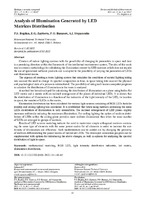Analysis of Illumination Generated by LED Matrices Distribution
| dc.contributor.author | Bogdan, P. S. | |
| dc.contributor.author | Zaytseva, E. G. | |
| dc.contributor.author | Baranov, P. O. | |
| dc.contributor.author | Stepanenko, A. I. | |
| dc.coverage.spatial | Минск | ru |
| dc.date.accessioned | 2022-04-06T10:53:56Z | |
| dc.date.available | 2022-04-06T10:53:56Z | |
| dc.date.issued | 2022 | |
| dc.identifier.citation | Analysis of Illumination Generated by LED Matrices Distribution = Analysis of Illumination Generated by LED Matrices Distribution / P. S. Bogdan [et al.] // Приборы и методы измерений. – 2022. – Т. 13, № 1. – С. 60-67. | ru |
| dc.identifier.uri | https://rep.bntu.by/handle/data/110952 | |
| dc.description.abstract | Сreation of indoor lighting systems with the possibility of changing its parameters in space and time is a promising direction within the framework of the intellectual environment system. The aim of this work was to create a methodology for calculating the illumination created by LED matrices which does not require the use of specialized software products and is adapted to the possibility of varying the parameters of LEDs and illuminated rooms. The urgency of creating a room lighting system that simulates the conditions of natural lighting taking into account the need to change its spectral composition in time, in space taking into account the physical and psychological state of a person is substantiated. The possibility of using well-known computer programs to calculate the distribution of illumination in the room is analyzed. A method has been developed for calculating the distribution of illumination on a plane using both a flat LED matrix and a matrix with an inclined arrangement of the planes of individual LEDs. It is shown that the distribution of illumination is a function of the indicatrix of the light intensity of the LED, its location in space, the number of LEDs in the matrix. Illumination distribution has been calculated for various light sources consisting of RGB LEDs both for desktop and ceiling lighting was calculated. It is established that when using matrices containing the same LEDs distribution of illumination is very nonuniform. The inclined arrangement of LED planes slightly increases uniformity reducing the maximum illumination. For ceiling lighting the option of uniform distribution of LEDs within the ceiling plane provides more uniform illumination than when the same number of LEDs are arranged in groups of matrices. Results of LED sources modeling indicate the need to modernize simple orthogonal matrices containing the same type of elements with the same power modes for all elements in order to increase the uniformity of illumination and efficiency. Such modernization can be carried out by changing the geometry of matrices differentiating the power modes of individual LEDs. The developed calculation program can be supplemented with options for introducing the above changes, as well as options for analyzing the spectral distribution of light in space. | ru |
| dc.language.iso | en | ru |
| dc.publisher | БНТУ | ru |
| dc.title | Analysis of Illumination Generated by LED Matrices Distribution | ru |
| dc.title.alternative | Analysis of Illumination Generated by LED Matrices Distribution | ru |
| dc.type | Article | ru |
| dc.identifier.doi | 10.21122/2220-9506-2022-13-1-60-67 | |
| local.description.annotation | Создание систем освещения помещений с возможностью изменения его параметров в пространстве и во времени является перспективным направлением в рамках системы «интеллектуальная окружающая среда». Целью данной работы было создание методики расчёта освещённости, создаваемой светодиодными матрицами, которая не требует применения специализированных программных продуктов и адаптирована к возможности варьирования параметров светодиодов и освещаемых помещений. Обоснована актуальность создания системы освещения помещений, имитирующей условия естественного освещения с учётом необходимости его изменения по спектральному составу во времени, в пространстве с учётом физического и психологического состояния человека. Проанализирована возможность использования известных компьютерных программ для расчёта распределения освещённости в помещении. Разработана методика расчёта распределения освещённости на плоскости при использовании как плоской светодиодной матрицы, так и матрицы с наклонным расположением плоскостей отдельных светодиодов. Показано, что распределение освещённости является функцией индикатрисы силы света светодиода, расположения его в пространстве, количества светодиодов в матрице. Произведён расчёт распределения освещённости для различных источников света, состоящих из RGB светодиодов, как для настольного, так и для потолочного освещения. Установлено, что при использовании матриц, содержащих одинаковые светодиоды, велика неравномерность распределения освещённости. Наклонное расположение плоскостей светодиодов незначительно увеличивает равномерность, уменьшая максимальную освещённость. Для потолочного освещения вариант равномерного распределения светодиодов в пределах потолочной плоскости обеспечивает более равномерное освещение, чем при расположении такого же количества светодиодов в виде групп матриц. Результаты моделирования светодиодных источников свидетельствуют о необходимости модернизации простых ортогональных матриц, содержащих однотипные элементы с одинаковым для всех элементов режимом питания, с целью повышения равномерности освещённости и экономичности. Такая модернизация может осуществляться за счёт изменения геометрии матриц, дифференциации режимов питания отдельных светодиодов. Разработанная программа расчёта может дополняться опциями для введения перечисленных выше изменений, а также опциями для анализа спектрального распределения излучения в пространстве. | ru |
Files in this item
This item appears in the following Collection(s)
-
Т. 13, № 1[8]

